The sight of cracked tires can ruin your day.
It’s a condition that affects your car’s movement and general safety if left unfixed. Unfortunately, cracked tires are inevitable. As your car begins to age and the tires are exposed to extreme temperatures, they start to show cracks.
To avoid putting your safety in jeopardy, it’s imperative to learn how to fix cracked tires. In this article, you’ll learn to identify cracks, their causes, how they are fixed, and how you can prevent them.
Table of Contents
It’s fairly easy to notice cracked tires. The following are signs that appear when there are cracks on your vehicle’s tires:
The rubber parts of tires are protected by oils and antioxidants. Frequent usage can make these protective compounds wear away. This makes your tires appear dry and brittle when felt.
Ever noticed splits and cracks on the sidewalls of your tires? They can appear on both sides and are the clearest sign that you have cracked tires.
Cracks can also appear on your tire tread’s outer edges. This is usually caused by dry rot at an advanced stage. The cracks might look small, but they can compromise your car’s handling even when the tread still has enough depth.
When your car tire’s black color begins to turn grey, there’s a chance it’s due to dry rot. Sometimes, the color starts fading before cracking happens. However, they can both happen at the same time as well.
Dry rot doesn’t happen overnight. It’s caused by several reasons including:
Storing your car in a garage and leaving it unused for a long period can leave the engine in a bad condition. But it can also suffer further damage due to dry rot. As earlier mentioned, tires are protected by oils and antioxidants.
But it can also suffer further damage due to dry rot. As earlier mentioned, tires are protected by oils and antioxidants.
When left unused, these protective compounds can evaporate or leach into the ground. This effectively removes your car’s protective layer, making it vulnerable to cracking
Like humans, cars age with time. The older they get, the less efficient their parts become. This is also true for car tires. After a while, the rubber begins to age, and dry rot sets in. The aging process can also be accelerated by heavy use.
With your tires running for many miles every day and being exposed to various elements, it will start to crack.
Extreme temperature and humidity are some of the elements that can cause your tires to deteriorate. While this process is gradual under normal conditions, it accelerates when the temperature is particularly high.
When the temperature is low, the rubber becomes rigid as it dries out.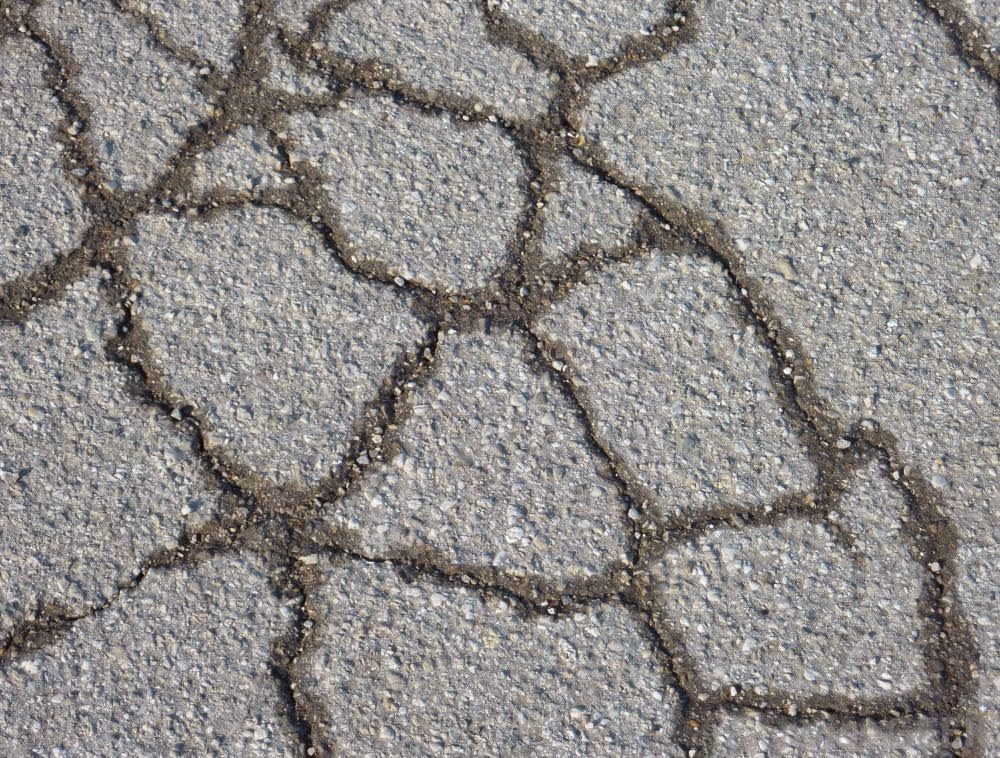 This allows dry rot to set in faster. Similarly, when the temperature is high, sunlight breaks down the rubber’s protective compounds causing tires to crack rapidly.
This allows dry rot to set in faster. Similarly, when the temperature is high, sunlight breaks down the rubber’s protective compounds causing tires to crack rapidly.
If your tires are made with low-quality materials, you can bet on dry rot to set in easily. Tires face different elements as well as static friction between them and the road. If the rubber and other components are substandard, the cracking process will happen much faster causing your tires to deteriorate at an alarming speed.
It’s crucial to get your car’s pressure right to avoid the effects of under or over-pressurized tires. One such effect is dry rot. When the tires are over-pressurized, there’s additional stress on the walls which may lead to bulging and eventually cause cracks. On the other hand, under-pressurized tires experience more friction with the road. This causes dry rot.
See Also – Tire Pressure Sensor Fault (Causes and How to Fix)
When dry rot sets in, you have the option to change your tires.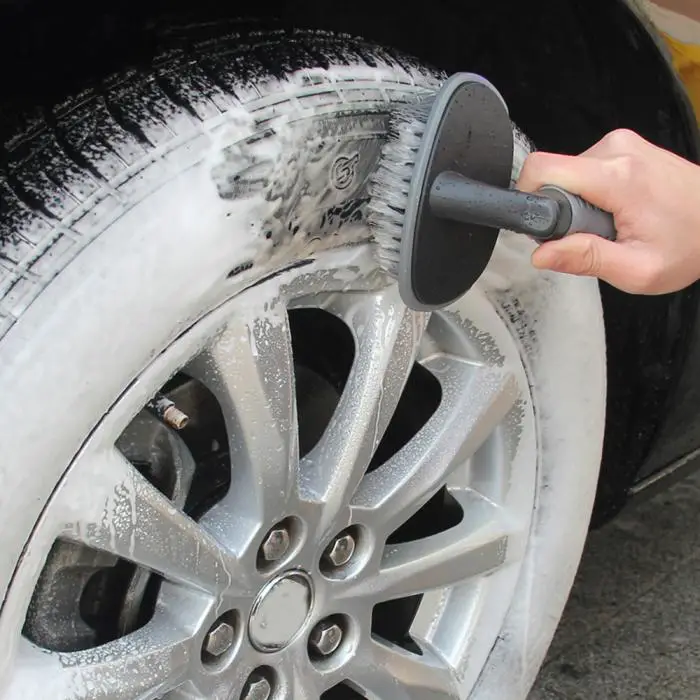 But If you’re not too thrilled with the idea of replacing your tires every year, it’s best to learn how to fix them. Below are steps to fix your cracked tires.
But If you’re not too thrilled with the idea of replacing your tires every year, it’s best to learn how to fix them. Below are steps to fix your cracked tires.
You can fix your cracked tires with sealants when the cracks are small and not obvious. To ensure this method is done right, you need to buy a sealant that’s suitable for your tires.
Here are the tools you need:
● Dry rot sealant that suits your tires
● Tire inflator
● Tire pressure gauge
● 1/2” Socket wrench or Lug wrench
Follow the steps below to fix your tires with a sealant:
As you may have noticed, your vehicle naturally heats up when driven. For tires, the heating up is a result of the friction between them and the ground. If you’ve recently driven your car, allow it to cool down before you fix the cracks with a sealant.
The next step is to jack up your vehicle and remove the affected tires.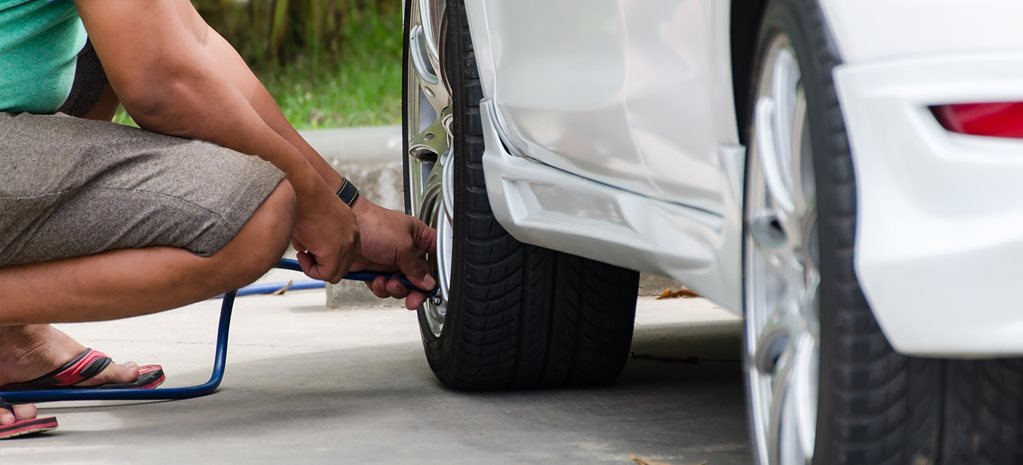 You can’t fix tires properly if they are not attached to your car. Therefore, you’ll need the lug wrench or the 1/2” socket wrench to take off your tires to allow you to fix them properly.
You can’t fix tires properly if they are not attached to your car. Therefore, you’ll need the lug wrench or the 1/2” socket wrench to take off your tires to allow you to fix them properly.
The level of damage will confirm if your tires are fixable or they need to be replaced. This inspection also allows you to see the area that’s damaged. With a clear idea of the situation, you can come up with a good plan to fix the tires.
Depending on the kind of sealant, you might need to prepare it according to the instructions. However, some sealants don’t need any special preparation. You can apply them right away. To apply the sealant on the insides of your tires, insert the injector into the valve stem.
With the sealant applied, your tires may have lost some air. Therefore, you need to re-inflate them. Use the pressure gauge to ensure you get the pressure right.
With your tires fixed, re-install them on your car. Some sealants require you to drive your car around immediately after installing. This helps the sealant to circulate and seal the cracks adequately.
For visible cracks, this method is ideal. A protectant can fix cracks and help protect the rubber from UV rays.
● Water hose
● Large sponge
● Water-based tire degreaser
● Tire protectant
Like the first method, you need to wait till your tires are cool before taking them out to examine. The inspection will show where the major problem is and if it’s fixable.
With the large sponge, apply the degreaser to your tires. Be sure to apply it to every area of the tires while focusing on the cracked areas. Scrub thoroughly to get the degreaser on the tire’s entire surface.
Scrub thoroughly to get the degreaser on the tire’s entire surface.
After applying the degreaser, allow your tires to dry. When dry, wipe down with a clean cloth and rinse with the water hose.
When the tires are dry from rinsing, apply the tire protectant. Following the instructions on the protectant, spray it across the tires’ entire surface.
When you’ve sprayed your tires, the cracks should be fixed. You can re-install your tires on your car. If you still see signs of dry rot, repeat the process for better results.
Your tires can’t stay new forever, but with the following measures, you can keep extending their lifespan and keep them from cracking too soon:
● Don’t buy low-quality tires
● Clean regularly
● Cover your car when parked outside
● Maintain ideal tire pressure
● Examine your tires regularly
● Apply protectants frequently
The average life of car tires is six years. After a few years, dry rot is bound to set in. But if you’re quick to fix them, you can easily extend your tire’s lifespan.
After a few years, dry rot is bound to set in. But if you’re quick to fix them, you can easily extend your tire’s lifespan.
See Also – What Are Radial Tires?
Tim Miller
Editor-in-Chief at GmundCars.com
Tim is a mechanic and car blogger from Denver, Colorado. He has over 10 years experience in car repair.
Latest posts by Tim Miller (see all)
“This post contains affiliate links, and I will be compensated if you make a purchase after clicking on my links.”
The tires are the most important parts of the car. If the tire is cracked, the movement will also be affected. Below we will tell you how to fix cracked tires – step by step guide.
If one of the other parts of the car is damaged, we can still move, but if it is a tire, it is certainly not possible. So the tire plays a very important role and you have to pay attention to it, check it often.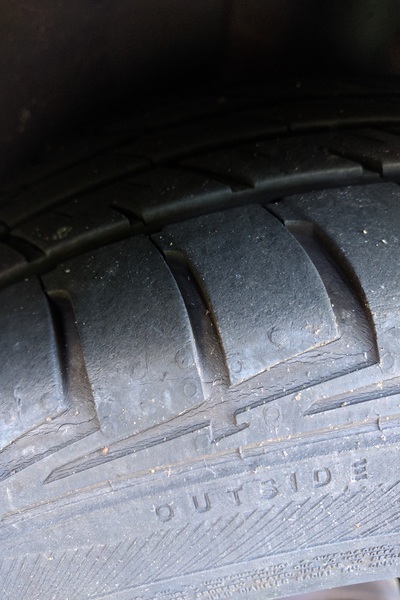 They are easy to damage and wear and not exist forever.
They are easy to damage and wear and not exist forever.
The most common problem you have with tires is cracks. Many mechanics and car repair centers will recommend replacing new tires, but that is very expensive. We will give you the main causes of the problems and how to fix them.
10 Year Anniversary Sale – Up to 50% off of thousands of tires
Valid through July 18, 2022
Available at SimpleTire.com
Contents
Before you try to fix a cracked tire, you should learn the common causes to prevent this in the first place.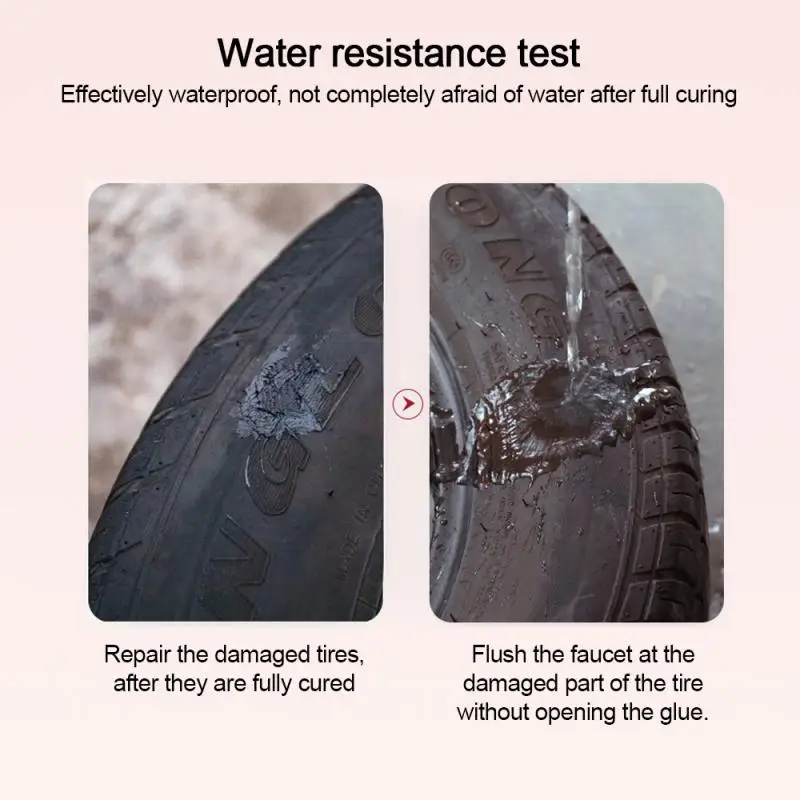
Your tires contain various compounds such as oils that keep in good condition, antioxidants. But when you use the car for a long time or keep the car in one place, these compounds will evaporate or seep into the ground on the road you move, there will be nothing to protect your tires. Moreover, the motors were also damaged.
High temperature is not good for rubber, it will be dry and cracked. Ultraviolet light will make the tires drier
Your money is not enough to buy high-quality tires so you choose to buy a less expensive model. In this case, it will have a perfect exterior shape but the interior is quite poorly built. That makes your tires more quickly damaged.
When the mechanic insists that you should maintain it, you should follow. The service will make your tires more smooth and safer.
Before changing tires you can try the methods below, it will save you money.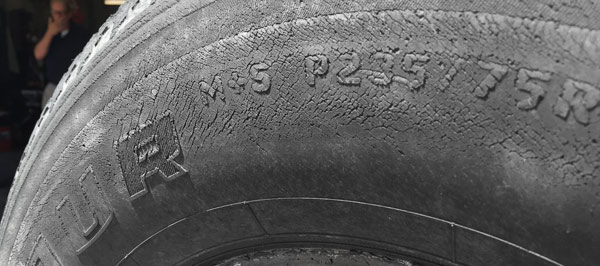 But few places can guarantee the safety of repairs, so please be aware, this repair is only temporary.
But few places can guarantee the safety of repairs, so please be aware, this repair is only temporary.
This method is like sealing a puncture, it will be effective for small cracks. The most important is that the sealant used is suitable for the type of tire you have.
You need to have:
Guide
Step 1: Check cracks and let the tires cool down
It is important to carefully examine the cracks on the tires, to determine which cracks you will repair. Then let the tire cool down after friction on the road.
Step 2: Remove the tire
Remove the tires once they have cooled. You cannot do the job if the tire is still sealed. You can only see the tire cracking both inside and outside when removing the tire. You will determine one more time before you start fixing the tire.
Step 3: Clean the position of the tire that needs repair
You can use carburetor cleaners, which are available at car repair shops. Use it to spray the locations of tires that need to be repaired and allow them to dry.
Step 4: Use sealant
After checking your tires. You will prepare a sealant suitable for the type of tire you are using, it needs to be mixed up.
Once the sealant is in place, apply it to the tires as instructed. Be careful as this may seal the injector or nozzle into the valve body. Completely eliminate any excess on the tire surface.
Step 5: Reinflate and reset tires
Use a pressure gauge to ensure an appropriate pressure level. This is important because working on tires can cause air loss.
Finally, reset your tire, check it again to see if it is sealed and you can drive around.
A protective agent will be a coating to shield against external harmful agents and rejuvenate rubber.
You need to have:
Guide
Step 1: Check cracks and let the tires cool down
Before working with tires, you need to let the tires cool down to ensure safety. Check outside for damaged tire locations.
Step 2: Remove to tire
Next to should remove the cracked tire. Like the above method, you cannot work when the tire is still on the vehicle. When the tire is removed, you need to clearly identify the areas that need to be repaired and their size to make sure that you don’t miss a part.
Step 3: Coat the degreaser
Apply degreaser to the tires after identifying cracks. And in every degreaser, there is a user manual included. You can use a sponge, apply some degreaser on it, and spread it evenly over the tires, covering the entire surface.
Step 4: Scrub and wash tires
Leave the degreaser on the tires for a few minutes.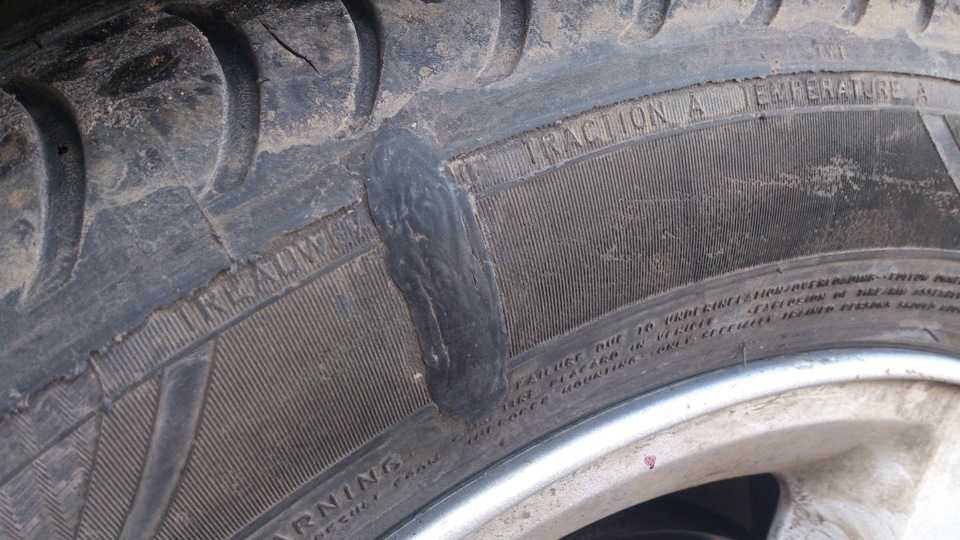 Then rub the surface of the tire with a sponge. Be more careful with cracks. Take a clean cloth and wipe thoroughly. After cleaning, place your faucet to gently wash the entire surface of the tire. Wash continuously until you are sure the tires are clean. Then let them dry for a while.
Then rub the surface of the tire with a sponge. Be more careful with cracks. Take a clean cloth and wipe thoroughly. After cleaning, place your faucet to gently wash the entire surface of the tire. Wash continuously until you are sure the tires are clean. Then let them dry for a while.
Step 5: Apply protective agent and reset tire
This is the most important step in the process. After the tire has dried, you need to apply protectants to the entire surface, not just the cracked area, there is no guarantee that the other situation will not occur. Most tire protectants take several hours to cure, you need to leave them alone. After performing all the above steps. You need to review the tire, if not satisfied, you can repeat the above process. If you feel it is okay, reinstall the tire. So you’ve completed this method.
Although when the tires are cracked you can repair them, it is better if you store the tires well in the first place.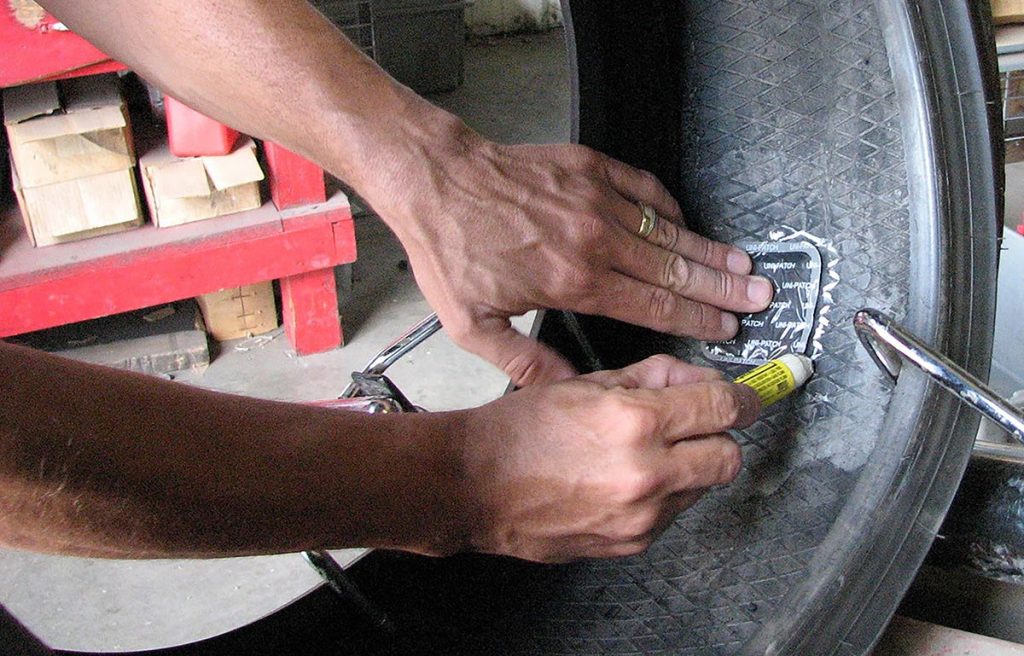 Here are some helpful tips for you:
Here are some helpful tips for you:
Above we have shown you how to fix cracked tires: step by step guide. Hope you find useful information from our article. Wish you are successful!
Contents
When changing tires, car owners often face tire deformation. Cracks in rubber are a worthy reason to think about replacing or restoring it. Small cracks sometimes cover the entire radius of the wheel, but it is still possible to move around the city on it, especially if the tires are tubeless, but leaving the city limits is not recommended. Large cracks with delamination coming from the cord itself require special care. And if such a phenomenon as bedsores, what to treat should be determined by a medical specialist, then the “treatment” of car tires from cracks is the business of automobile “doctors”.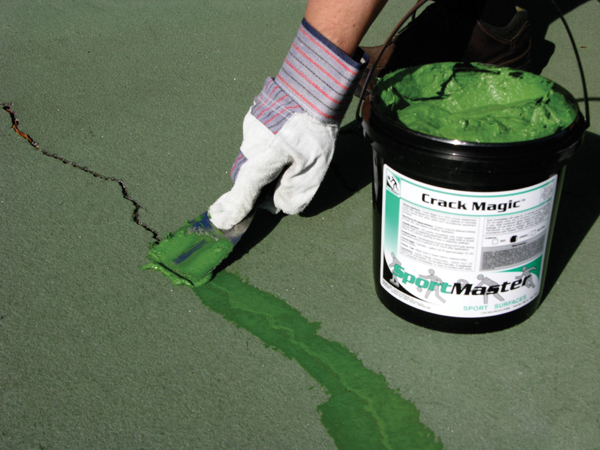
It is worth taking therapeutic and preventive measures for the rubber of your car in a specialized center. The method of restoring rubber is melting or welding. But here you need to consider two points that any motorist should know. Firstly, it is necessary to take into account the wear of rubber, because restoration - no matter how much we would like it, the pleasure is not cheap and sometimes simply does not justify itself. Secondly, when it comes to tires and, especially, brakes, savings are out of the question.
In addition to the rubber on the wheels, the rubber elements of the body kit and the seals of the trunk and doors can also crack.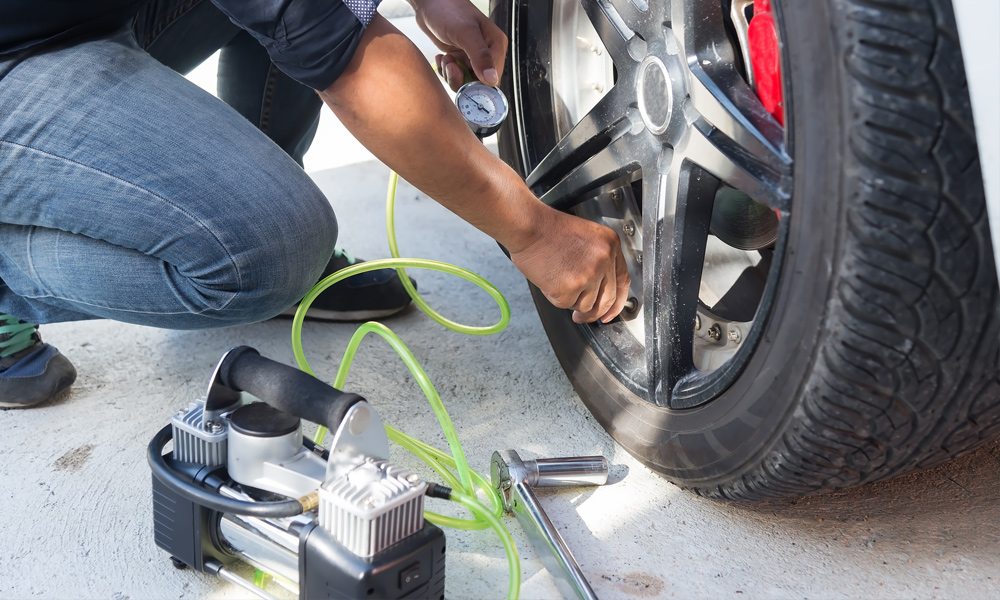 And if the most effective remedy for pressure sores, for example, "Proteox-TM" is a thin wound dressing with the main components intended for the treatment of various pressure sores, including those infected. That professional care product for rubber elements can be at least "Gummi - Pflege Stift", developed by Sonax and outwardly resembling a marker pencil. The tool is focused on restoring the elasticity of rubber, cleaning its surfaces from dirt and giving a characteristic shine. The tip of the pencil moves, actively introducing the so-called silicone component into the surface of the rubber coating, which forms a stable film that prevents cracking and aging of the rubber. Take care of your tires, have a marker pen in your glove compartment and may your road be successful!
And if the most effective remedy for pressure sores, for example, "Proteox-TM" is a thin wound dressing with the main components intended for the treatment of various pressure sores, including those infected. That professional care product for rubber elements can be at least "Gummi - Pflege Stift", developed by Sonax and outwardly resembling a marker pencil. The tool is focused on restoring the elasticity of rubber, cleaning its surfaces from dirt and giving a characteristic shine. The tip of the pencil moves, actively introducing the so-called silicone component into the surface of the rubber coating, which forms a stable film that prevents cracking and aging of the rubber. Take care of your tires, have a marker pen in your glove compartment and may your road be successful!
When noticing tire cracks, many vehicle owners ask themselves: “Is it time to change tires right away or can I drive a little more?” Experts recommend not to take risks and replace the rubber on which cracks have appeared in time.
Very small or deep cracks in the tire tread occur due to several reasons. The appearance of cracking on the surface of the rubber, outwardly resembling a cobweb, which has a depth of no more than 2 mm, is a sure sign of improper storage of tires. Most likely, the tire was exposed to ultraviolet rays for a long time or lay in a room where there were temperature fluctuations.
Small cracks in the grooves on the tire occur as a result of the impact on the wheel of chemical reagents that are part of the asphalt mixture, sand-salt compositions, which are sprinkled on roads in ice.
Cracks greater than 3 mm in depth are caused by tire wear from long-term use. The resins and oils used in the production of wheels gradually evaporate, and the rubber loses its elasticity.
Another reason that causes cracks in the tire tread pattern is inaccurate wheel beading. The cord can be damaged by an inexperienced craftsman involved in this procedure or poor-quality equipment used at some service stations.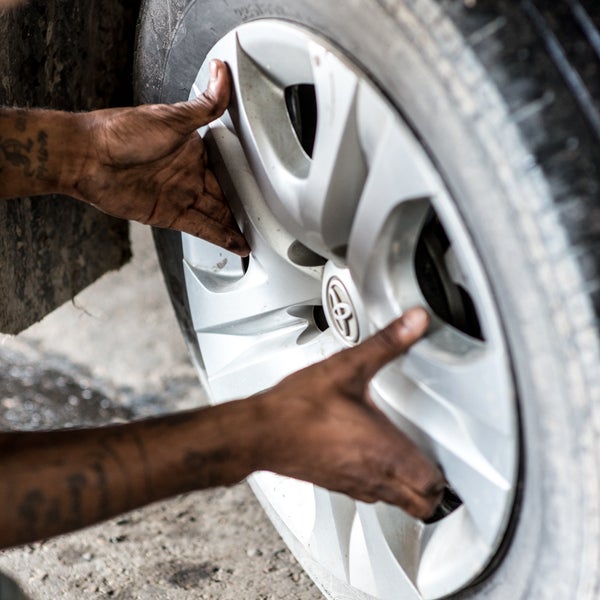
Small cracks on the surface of the tire - a cosmetic defect that does not pose a danger. But tires with deep longitudinal or transverse cracks can fail at any time. In order not to endanger the lives of the driver and passengers, they are recommended to be replaced.
The answer to the question of whether it is possible to drive with cracks on tires depends on the degree of tire damage. In the presence of small grooves, operation is allowed subject to certain conditions:
In case of deep cracks in the wheel, the tire must be replaced as soon as possible. Such damage is associated with the separation of the metal cord from the rubber coating. During the movement of the vehicle, dirt, moisture, and reagents that have been used to treat roads inevitably get inside the damaged tire. This leads to damage to the disc, and the tire may burst while driving.
This leads to damage to the disc, and the tire may burst while driving.
If there are only cobwebs of small cracks on the wheel, experts recommend treating the tire with a special silicone compound that slows down the aging of rubber.
If there are deep longitudinal or transverse damage, there is no question of how to repair cracks in the tires. In this case, the use of damaged rubber is strictly prohibited. You will need to replace the kit with a new one.
Another change season is approaching. And perhaps you remember that on one of the tires after the last winter / summer there is a jamb - a small bump. For the sake of one new tire, you don’t want to run to the store. We understand. Or maybe even better if repaired?
Yes, not every wheel that has met with a nail, rebar sticking out of the ground or a sharp stone on the road is considered damaged.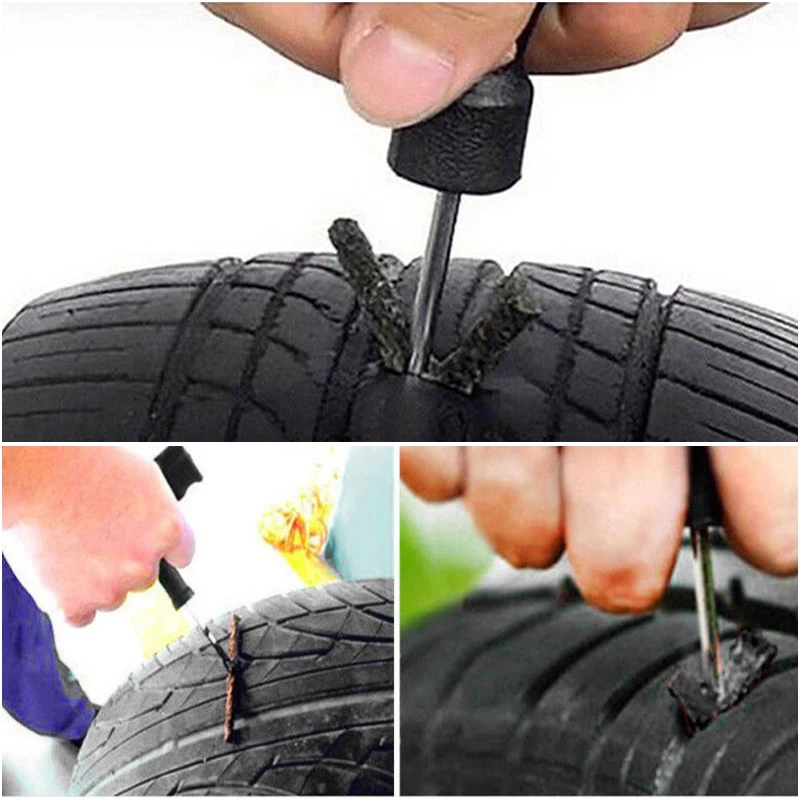 Everything, of course, depends on the scale of the damage and its location on the tire itself. Some are easily repaired, while others are simply impossible to do - send the tire only to the trash.
Everything, of course, depends on the scale of the damage and its location on the tire itself. Some are easily repaired, while others are simply impossible to do - send the tire only to the trash.
A bulge on a wheel, referred to by drivers as a bump or bulge, is the most common tire sidewall defect. It appears due to a collision with an obstacle or after falling into a pit, more often at high speed. The threads of the sidewall carcass are easily damaged by impact, and the tire at this point can no longer hold the load and air pressure - swelling appears. A small bump sooner or later turns into a big one, and driving with such a defect is dangerous - the wheel can shoot at any moment. At high speed, this is fraught with loss of control, departure from the road and a coup.
Some types of hernias are repairable, although this is a temporary measure. No patch will be able to restore the factory rigidity. Ideally, change the tire.
Special cord patches can extend the life of a tire with a herniation, even if the swelling has appeared on the tread.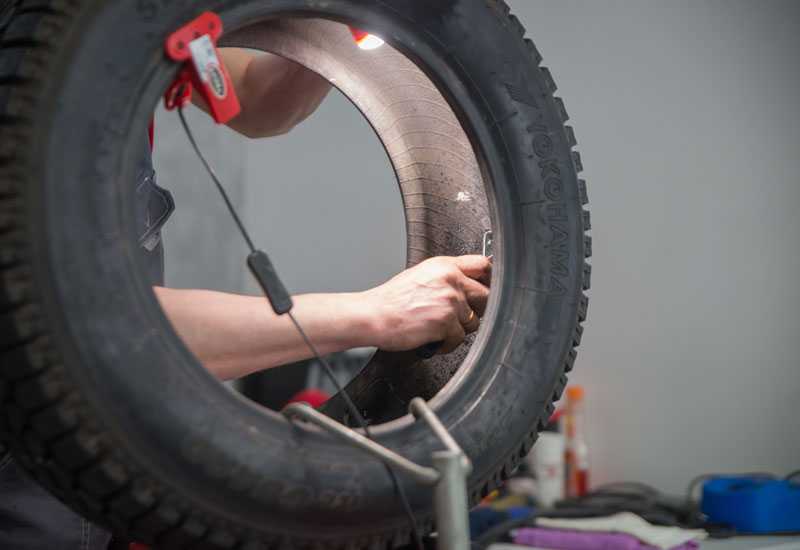 The sidewall is a different story. If the swelling appeared at a distance of more than 40 mm from the side, it can be repaired. If not, then the wheel needs to be replaced. Blisters on low profile tires are most often non-repairable.
The sidewall is a different story. If the swelling appeared at a distance of more than 40 mm from the side, it can be repaired. If not, then the wheel needs to be replaced. Blisters on low profile tires are most often non-repairable.
For maximum safety when riding with a repaired bump, insert the tube. This is an inexpensive and reliable solution. On our market, you can find cameras made in China and Russia, the latter are a little more expensive, but also of better quality.
The elimination of a side cut is a serious operation, therefore, as in the case of a bump, you will have to go to the professionals. We need cord patches, fortunately in our time they are of different sizes and with a different number of layers. And if you do it wisely, then you can not do without special tools and vulcanization.
A cut, by the way, cannot be healed in all cases. If the gap is in the shoulder area of the tire, it is unlikely that anyone will undertake to repair it, since no guarantees can be given here. However, our Kulibins take on even the most difficult cases, cutting out parts of the sidewalls from the tires and even weaving the cord on their own.
However, our Kulibins take on even the most difficult cases, cutting out parts of the sidewalls from the tires and even weaving the cord on their own.
Low profile tires can be repaired but more difficult. A sidewall tear is easier to seal on medium or high profile tyres.
Sometimes a cut is confused with a pluck. This is when the outer layer of the sidewall caught on something sharp, a tear formed, but the frame itself remained intact. There is nothing wrong with this, although the drivers at the tire shop successfully repair the cut, for which they take it, respectively.
If a piece of rubber remains on the sidewall, then glue it with ordinary superglue (101st). If it came off, it is better to cover it with raw rubber and vulcanize. Leaving the pluck bare is not recommended, because the tire carcass, often consisting of a metal cord, will quickly corrode.
Cuts and bulges are not the only possible sidewall damage.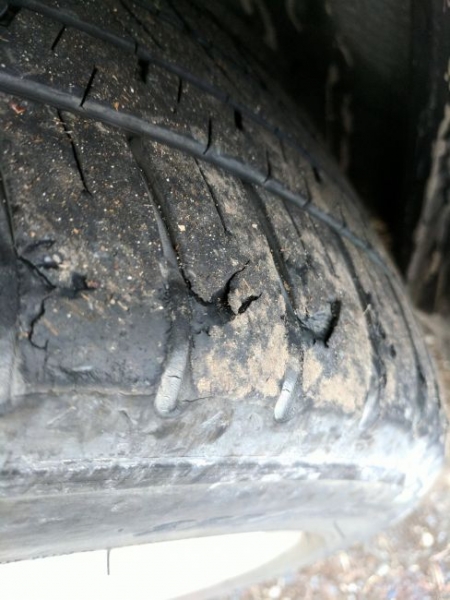 You can also spoil the side ring, in the process of changing shoes, for example. If on garlic, then such a tire is already dangerous. Sooner or later the pressure in the tire and the load in motion will start pushing the rubber off the rim - a wheel explosion can occur.
You can also spoil the side ring, in the process of changing shoes, for example. If on garlic, then such a tire is already dangerous. Sooner or later the pressure in the tire and the load in motion will start pushing the rubber off the rim - a wheel explosion can occur.
This ailment is repaired if the wire ring - the base - is intact. There are no special technologies and materials to correct this particular problem, but most often craftsmen use a two-component composition for chemical (also called cold) vulcanization. After mixing, the mass is pressed into a fat-free damage. Compound manufacturers recommend waiting 72 hours before mounting a tire. Of course, our masters do not pay attention to this condition - they put the tire right away. And it’s good if the wheel is lowered because of this at night in the parking lot, and not on the road.
If the side ring tears are barely noticeable, but the wheel still deflates, then you can use a special liquid - a bead sealer designed to seal a tubeless tire.
These seals have been used in motorsport for some time. In particular, in the American drift series Formula D, the pilots used compounds to keep the tire on the disc even with minimal pressure in the wheel. Now they are banned.
Every schoolboy has experienced this problem when patching up his bike's inner tube after hitting something sharp. Repairing a car tire puncture with your own hands will also not be difficult even on the road. But for this you will need a pump (or compressor) and a universal tire repair kit with harnesses. All this is sold at any car market or gas station.
Repairing a tire on the roadside with harnesses
The process is simple. If we are talking about the front wheels, then in most cases the wheel can not even be removed, it is enough to turn the steering wheel in the right direction, find the puncture site and carry out repairs. First, the hole is cleaned with a helical awl from the set. The tourniquet itself is smeared with glue and tucked into the eye of the awl, after which it is inserted into the tire hole. With a sharp movement, the tool is removed, and the tourniquet remains in place and clogs the hole. The tails are cut with a knife, but not at the root, it is recommended to leave about 20 mm. The tire is inflated and checked.
The tourniquet itself is smeared with glue and tucked into the eye of the awl, after which it is inserted into the tire hole. With a sharp movement, the tool is removed, and the tourniquet remains in place and clogs the hole. The tails are cut with a knife, but not at the root, it is recommended to leave about 20 mm. The tire is inflated and checked.
Sometimes a nail or self-tapping screw clogs the hole itself, remaining in it. If you see a hat in the tread, do not rush to pull it out. While the pressure is holding, move to vulcanize. And sometimes they drive with a screw in a tire for weeks.
Repair of a puncture at a tire shop
Punctures are also repaired with harnesses at a specialized service, although among professionals such repairs are not considered long-term. After a few months, the flagella dry out and can pass air. There are more advanced methods like cold and hot vulcanization. The latter is more reliable. In this case, the hole is sealed with an elastic patch, and the funnel from a foreign object is filled with a special compound.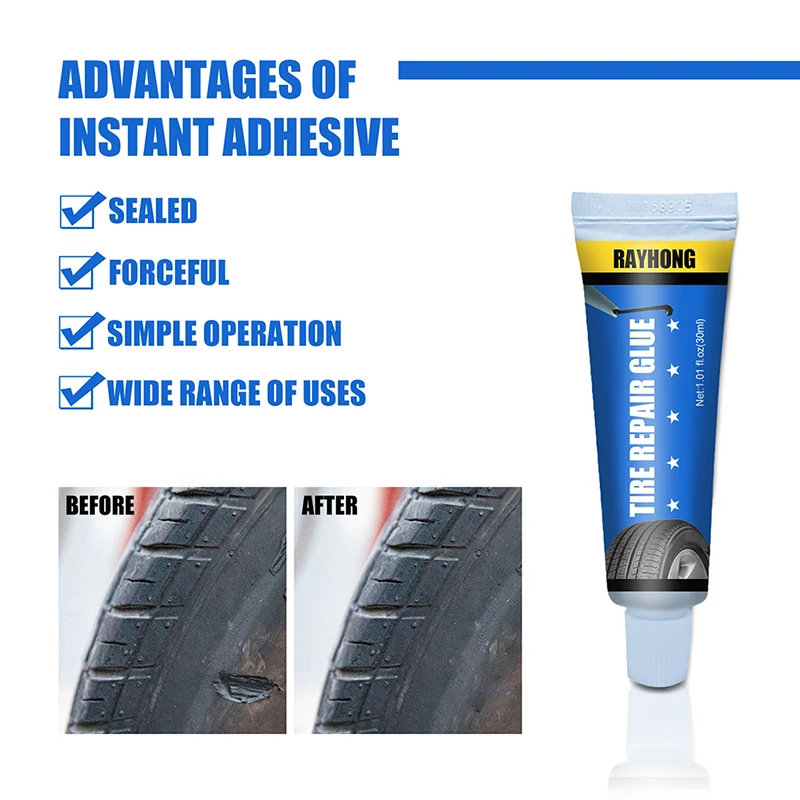 After the vulcanizer is put on the tire, it heats the rubber and solder it.
After the vulcanizer is put on the tire, it heats the rubber and solder it.
In addition to the plaster, the puncture is also repaired with special cord fungi. Masters process the puncture site: drill it and process the surface with a tool to roughen it. Then the repair area is lubricated with glue (it is also called cement) and a fungus is introduced. This is done from the inside of the tire. The cap of the fungus is rolled, and the excess legs are simply cut off from the outside.
Repairing a puncture with sealant
With the advent of tubeless wheels and later run flat tires, many automakers began to forego spare wheels. Instead, repair kits with compressors are supplied with the machines. A repair kit is essentially a bottle of pressurized sealant. Later, such spray cans began to appear on the shelves of ordinary car dealerships.
This method has not taken root in the CIS, because the condition of the roads forces you to have at least a stowaway in the kit, but you can also consider it as a way to repair on the road.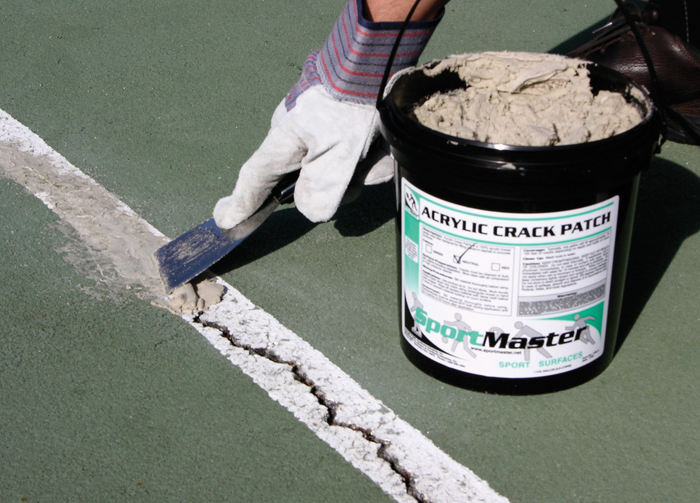
The car must be jacked up and the sealant must be pumped into the damaged wheel through the nipple. Next, you should spin the wheel, then pump it up, lower the car and drive a few hundred meters. If the tire tightness is not restored, repeat the procedure.
For commercial vehicles, cutting the tread with a special device (regrower) is a common thing. Moreover, such tire retreading is provided by the factory (marked REGROOVABLE on the sidewall) to increase the service life. But there are entrepreneurs who undertake to deepen the grooves in tires for passenger cars. But they are not intended for such an operation. Often, used tires for sale are “refreshed” in this way. Be careful!
What is the threat?
The worst option is that the retreaded tire will shoot out on the road, as when deepening the grooves, the master can damage the undertread layer. Such a tire at some point will not be able to hold pressure.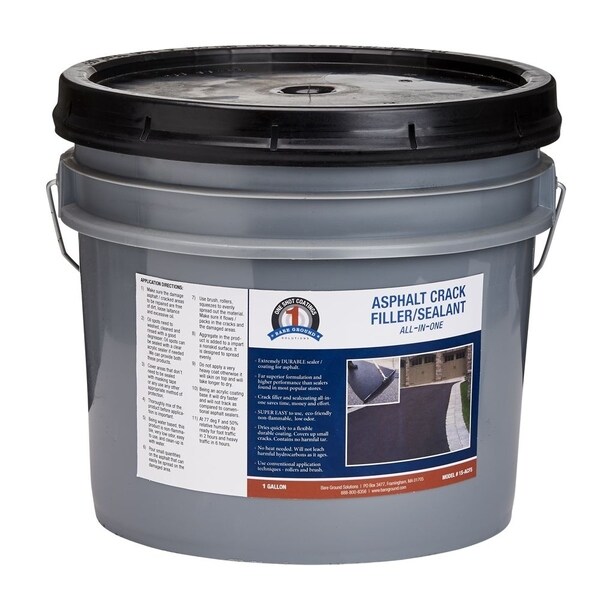 There will be a boom! At best, the tire will indeed last a little longer, but is the game worth the candle? We think it's not worth it.
There will be a boom! At best, the tire will indeed last a little longer, but is the game worth the candle? We think it's not worth it.
How is cutting done?
A regrower is used to cut the tread. Roughly speaking, this is a large soldering iron with interchangeable tips of various shapes. It goes through rubber like a knife through butter.
If the tire is for passenger cars, then it is worth taking on the regrower only in one case - when part of the tread pattern was welded with "new" rubber during the repair. This is where cutting comes in handy in order to restore the grooves and symmetry of the tread.
Vehicle operation is prohibited if:
— tires have a residual tread height of less than 1.6 mm;
- tires have punctures, cuts, ruptures that expose the cord, as well as delamination of the carcass, delamination of the tread and sidewall;
- tires in size or load capacity do not match the car model;
- tires of various sizes, designs (radial, diagonal, chamber, tubeless), models, with different tread patterns, winter and summer, studded and non-studded, new and restored, are installed on one axle of the car;
— Tires retreaded according to the second repair class are installed on the front axle.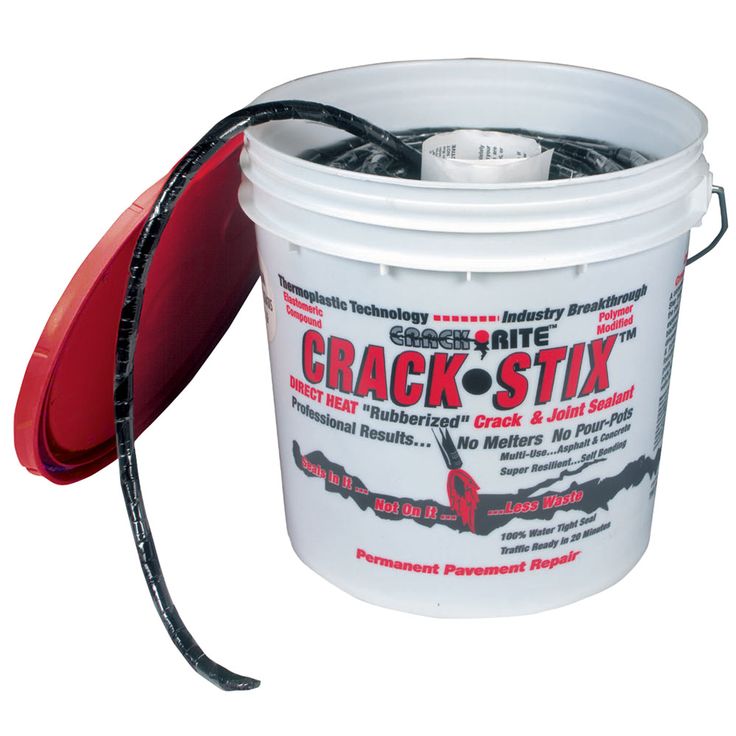
What is the second class of repair?
This is the case when the carcass of the tire is restored after serious damage. A side cut (or tear) is a serious damage to the tire carcass.
Car tires are designed to last for a certain period of time. But under the influence of various factors, this period can be significantly reduced. This is mainly due to the quality of tires, their operating conditions, as well as compliance with the rules of seasonal storage.
Quite often, motorists are faced with the problem of cracks in rubber. This phenomenon has its reasons. But most of all, drivers are interested in the question of what to do with cracked tires and whether they can continue to be used.
To make the right decision, you need to understand the causes of cracks, their varieties and the degree of danger.
Every motorist must know why tires suddenly crack on his car and what leads to such a situation.
There are several potential causes. They can appear singly or act as a fusion of several factors at the same time.

As you can see, there is nothing supernatural here. The reasons are quite banal and obvious. But even this does not solve the problem of cracking. Many motorists stubbornly continue to violate all the rules and recommendations. Hence the corresponding consequences.
The cracks themselves on car tires can appear directly in the tread area, or on the side. It is about lateral cracking that is most often discussed.
Before deciding how to proceed, it is necessary to determine what kind of side cracks on the tires the motorist encountered.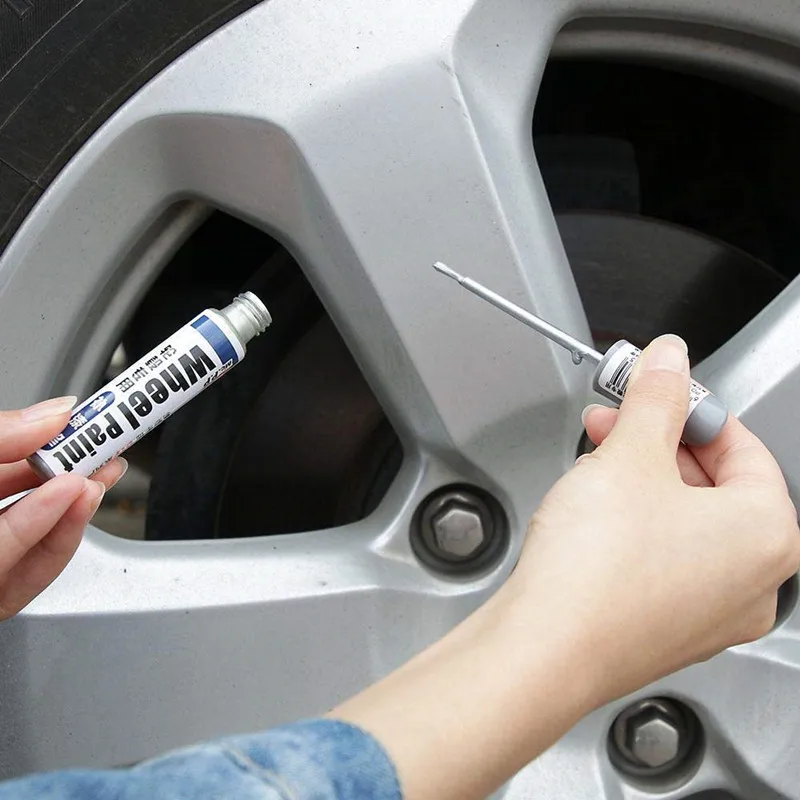 They are divided into 2 categories.
They are divided into 2 categories.
It is important to answer the question of whether you can continue to drive a car if a crack has developed on the side of the tire.
To understand whether it is possible to continue driving a car if cracks appear on the side of the rubber, it is necessary to start from specific circumstances.
First, consider how serious the damage is. With small and shallow defects, operation is allowed.
Even with small cracks, driving on such wheels is allowed within the city and at low speeds.
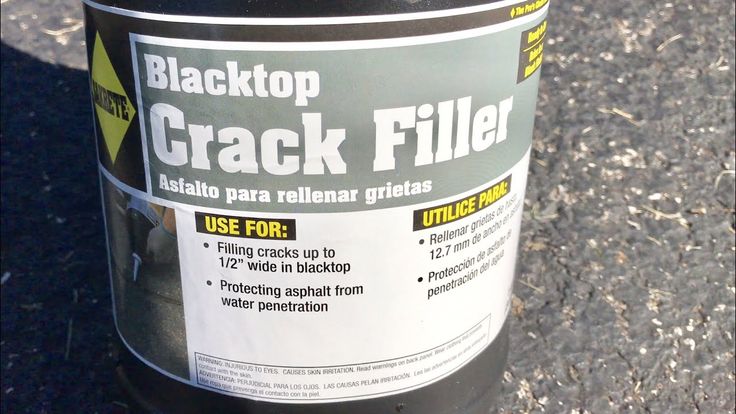
Traveling outside the city, moving along highways and speeds above 60-80 km/h is strongly not recommended. This can lead to further propagation of cracks with their subsequent rupture at speed. This will already entail a loss of control with all the ensuing dangerous consequences.
If these are small cracks, then severe restrictions are imposed on subsequent operation:
All this allows you to ride on old tires for some time, until the first opportunity to replace them appears.
Strictly restricted operation with lateral cracks only. If the tread is damaged, even a small defect precludes further driving.
Since the tread is damaged, the crack will actively expand and grow in size on subsequent trips.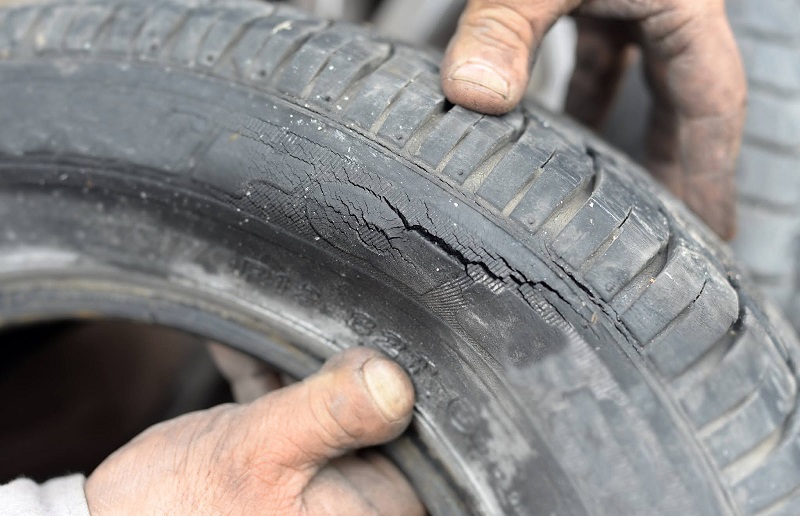 Even under the condition that the motorist drives extremely carefully, does not exceed the speed of more than 60 km / h and turns smoothly.
Even under the condition that the motorist drives extremely carefully, does not exceed the speed of more than 60 km / h and turns smoothly.
As for whether you can continue to ride on rubber if there are more serious cracks. About deep cracks can be said unambiguously. Operation is prohibited. It's too dangerous even to drive to the nearest service station or tire shop.
Deep damage can lead to the destruction of the cord, moreover, suddenly, at low speed. As a result, the tire will literally fall apart on the go. Trying to accelerate, an explosion is not ruled out. It is not difficult to guess the consequences.
Particularly frugal drivers who are trying to save every penny and not spend extra money on their car are wondering if tires can be repaired if they develop cracks.
The answer to this question again depends on the specific circumstances.
There are craftsmen who are ready to do anything the client asks for money. At the same time, they are silent about the consequences that repairs of this kind can lead to.
At the same time, they are silent about the consequences that repairs of this kind can lead to.
You should figure out what to do in such a situation and how you can treat your tires so that they do not crack further. In this regard, it is worth making some recommendations.
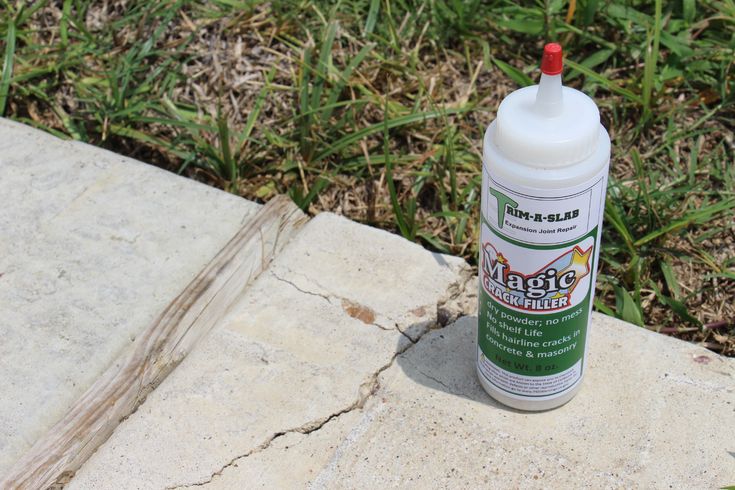 It is a liquid or silicone-based spray. They are positioned as means to slow down the aging of rubber. They work pretty well. But it is better to use them even before the first cracks appear, purely for the prevention and extension of the life of the rubber set.
It is a liquid or silicone-based spray. They are positioned as means to slow down the aging of rubber. They work pretty well. But it is better to use them even before the first cracks appear, purely for the prevention and extension of the life of the rubber set.
The most correct solution in such a situation, when the rubber has been in use for quite a long time, and this manifests itself in the form of defects, will be a complete replacement of the entire set.
Motorists naturally do not want a repetition of such situations. Cracks do create problems and require additional financial costs. And it is unlikely that someone will voluntarily want to change the wheel every season. Quality tires are not cheap.
In order to prevent such problems, it is necessary to adhere to the elementary rules of operation, as well as to engage in the prevention of rubber.
This involves following a few simple guidelines:
 The better it is, the longer and more efficiently it will last. Good tires provide confident cornering, strong grip, and are not characterized by problems such as cracking.
The better it is, the longer and more efficiently it will last. Good tires provide confident cornering, strong grip, and are not characterized by problems such as cracking. 